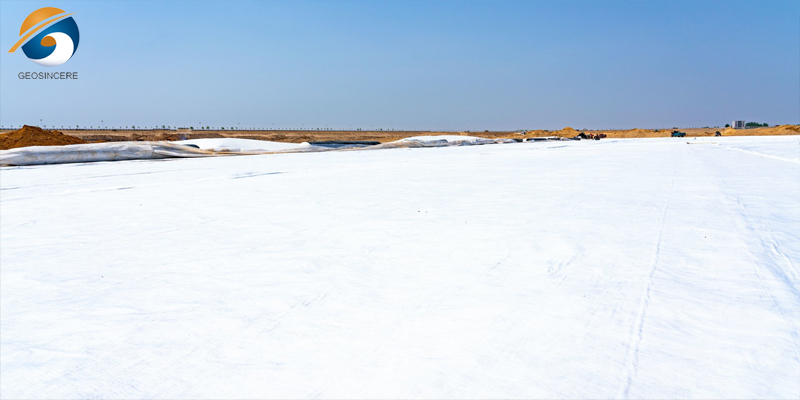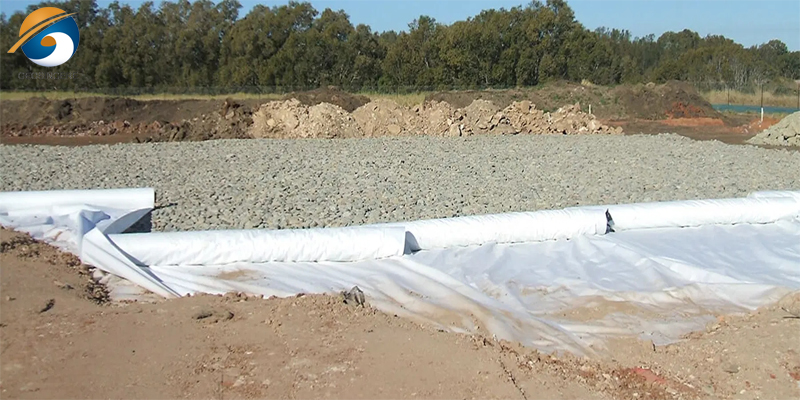What is Staple Fiber Needle Punched Geotextile and Its Application?
Geotextiles are permeable fabrics widely used in civil engineering, environmental projects, and construction to enhance soil stability, control erosion, and improve drainage. Among the various types of geotextiles, staple fiber needle punched geotextile stands out for its unique manufacturing process, versatility, and cost-effectiveness. This article explores the composition, production, properties, and applications of this material, highlighting its importance in modern infrastructure projects.
1.What is Staple Fiber Needle Punched Geotextile?
1.1Definition and Composition
Staple fiber needle punched geotextile is a **non-woven fabric** made from synthetic fibers such as polyester (PET) or polypropylene (PP). The term "staple fiber" refers to short, discrete fibers (typically 3–15 cm in length) that are mechanically entangled using a needle-punching process. Unlike woven geotextiles, which rely on interlaced yarns, non-woven geotextiles derive their strength from the random orientation of fibers bonded together through physical or chemical means.
1.2Manufacturing Process
The production of needle-punched geotextiles involves three key steps:
1.2.1Fiber Preparation:
Synthetic fibers are carded (aligned into a web-like structure) to create a uniform layer. Recycled or virgin fibers may be used, depending on the desired quality and application.
1.2.2Needle Punching:
The fiber web is fed into a needle loom equipped with barbed needles. These needles repeatedly puncture the web, entangling the fibers vertically and horizontally. This mechanical bonding creates a dense, three-dimensional structure with high tensile strength and porosity.
1.2.3Finishing
The fabric may undergo additional treatments, such as calendaring (heat pressing) or chemical coatings, to enhance specific properties like UV resistance or filtration efficiency.
2. Key Properties of Staple Fiber Needle Punched Geotextile
2.1 High Tensile Strength and Durability
The needle-punching process interlocks fibers in multiple directions, providing excellent resistance to tearing and puncturing. This makes the geotextile suitable for heavy-load applications like road construction.
2.2 Permeability and Filtration
The non-woven structure allows water to pass through while retaining soil particles. This dual functionality prevents clogging and ensures effective drainage in systems like retaining walls or subsurface drains.
2.3 Separation and Stabilization
When placed between two dissimilar soil layers (e.g., gravel and clay), the geotextile prevents intermixing, maintaining the structural integrity of both layers. It also distributes loads evenly, reducing settlement.
2.4 Chemical and Biological Resistance
Polypropylene and polyester fibers are inherently resistant to rot, mold, and most chemicals, ensuring long-term performance in harsh environments.
2.5 Cost-Effectiveness
Compared to woven geotextiles, needle-punched variants are generally cheaper to produce due to simpler manufacturing processes and the use of recycled materials.
3. Applications of Staple Fiber Needle Punched Geotextile
3.1. Road and Railway Construction
- Subgrade Stabilization:
The geotextile is laid over weak soil subgrades to distribute traffic loads and reduce rutting. For example, in highways, it minimizes differential settlement between soft soil and aggregate layers.
- Pavement Reinforcement:
By separating base layers (e.g., crushed stone) from subsoil, the fabric prevents contamination and extends pavement lifespan.
3.2. Erosion Control
- Slope Protection:
On embankments or hillsides, the geotextile anchors vegetation or rock layers, preventing soil erosion caused by rainfall or wind.
- Riverbank Revetment:
Combined with gabions or riprap, it stabilizes riverbanks against water flow.
3.3. Drainage Systems
- Landfill Leachate Collection:
In landfills, the geotextile acts as a filter layer in leachate collection systems, allowing liquid to drain while blocking fine particles.
- French Drains:
Wrapped around perforated pipes, it prevents soil intrusion and enhances water flow.
3.4. Agriculture and Landscaping
- Weed Control:
Used beneath gravel paths or garden beds, the geotextile suppresses weed growth while permitting water infiltration.
- Greenhouse Flooring:
It provides a stable, permeable base for greenhouse floors, improving hygiene and drainage.
3.5. Environmental Protection
- Sediment Control:
Temporary silt fences made of geotextile trap sediment at construction sites, protecting waterways from pollution.
- Wetland Restoration:
The fabric supports vegetation growth in wetland areas by stabilizing soil and reducing erosion.
4. Advantages Over Other Geotextile Types
While woven geotextiles excel in applications requiring ultra-high tensile strength (e.g., steep slope reinforcement), needle-punched non-woven geotextiles offer superior filtration and drainage capabilities. Their three-dimensional structure allows water to flow freely while maintaining soil stability, making them ideal for projects where both separation and drainage are critical. In contrast, heat-bonded non-woven geotextiles, created by melting fibers together, lack the mechanical strength of needle-punched variants and are better suited for lightweight applications like landscaping.
Cost is another differentiating factor. Woven geotextiles, often made from high-tenacity yarns, are more expensive due to complex weaving processes. Needle-punched geotextiles, on the other hand, leverage recycled materials and simpler production techniques, offering a budget-friendly solution without compromising performance. Additionally, their flexibility allows them to conform to uneven surfaces, reducing installation time and labor costs in projects like road repairs or landfill lining.
5. Case Study: Use in Highway Construction
Project: Rehabilitation of a coastal highway in Florida, USA.
Challenge: Soft, sandy subgrade prone to shifting under heavy traffic.
Solution: A 200 g/m² polypropylene needle-punched geotextile was installed between the subgrade and crushed stone base.
Outcome:
- Reduced rut depth by 40% over 5 years.
- Extended maintenance intervals by 3–4 years.
- Lowered project costs by 15% compared to woven alternatives.
6. Future Trends and Innovations
5.1. Eco-Friendly Materials:
Research into biodegradable fibers (e.g., jute or PLA) aims to reduce the environmental footprint of geotextiles.
5.2. Smart Geotextiles:
Integration of sensors to monitor strain, moisture, or temperature in real time for infrastructure health assessment.
5.3. Hybrid Fabrics:
Combining needle-punched geotextiles with geogrids or geomembranes for multifunctional applications.
6. Conclusion
Staple fiber needle punched geotextile is a cornerstone of modern geotechnical engineering, offering a blend of durability, filtration, and cost efficiency. Its applications span from roadways to environmental protection, demonstrating its adaptability to diverse challenges. As technology evolves, this material will continue to play a vital role in sustainable infrastructure development worldwide. Innovations in eco-friendly materials and smart textiles promise to further expand its utility, ensuring it remains indispensable in solving the engineering problems of tomorrow. Shandong Geosino provide one stop solution for geosynthetics, with years experience from 20+years technician team, Material in a variety to satisfy your different need on various projects,please contact us for more information!








